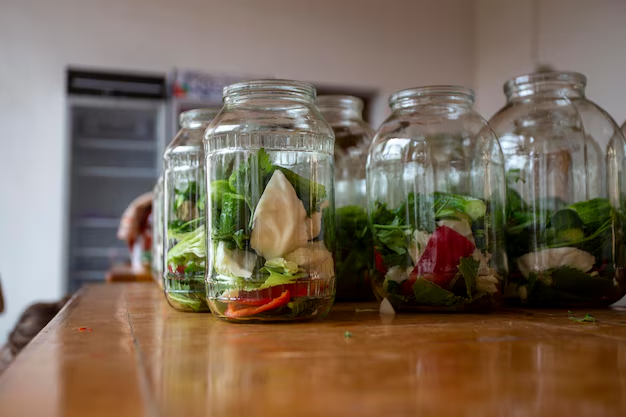How Long Does Kimchi Last in the Refrigerator? Unveiling the Secrets of Fermented Flavor
Picture this: a jar of vibrant, spicy kimchi waiting for you in the refrigerator. Whether you’re a culinary adventurer or a dedicated kimchi lover, understanding how long your kimchi stays fresh is essential. Kimchi is not just a food; it’s an art of fermentation that enriches flavor over time. But how long can you keep it in the fridge before it goes from delectable to disaster?
Understanding Kimchi's Lifespan
Fermentation: The Heart of Kimchi
Kimchi, a traditional Korean side dish, owes its longevity to the process of fermentation. During this transformation, natural bacteria convert sugars into lactic acid, which acts as a preservative. This not only extends the shelf life but also enriches the flavor profile—it gets tangy, spicy, and complex as it ages. However, like all good things, there is a limit.
General Timeframes: What to Expect
Typically, store-bought kimchi can remain good for 3 to 6 months after opening, depending on storage conditions and the initial freshness upon purchase. Homemade kimchi, owing to potential variations in preparation, might last slightly less, around 2 to 3 months on average. But there’s more nuance to it.
Factors Influencing Kimchi's Shelf Life
Storage Temperature
Temperature control is crucial. Kimchi thrives in the cold, so keeping it in the colder sections of the fridge—ideally between 32°F and 39°F—will optimize its longevity and maintain its zest.
Type of Kimchi
Different types of kimchi may age differently. For instance, cabbage-based kimchi like napa tends to last longer than radish or cucumber varieties, which might become mushy as they age.
Ingredients Matter
Ingredients affect fermentation. Fish sauce and fruits can accelerate spoilage, while simpler versions with garlic, ginger, and chili peppers might last longer.
Identifying Fresh vs. Spoiled Kimchi
Signs of Spoilage
It’s essential to recognize when kimchi has taken a turn for the worse. Here are some telltale signs:
- Unpleasant odor: A sour smell is normal, but if it turns rancid or off-putting, it might be time to toss it.
- Mold presence: If you see mold, especially black or dark mold, discard the whole jar.
- Texture change: Unappealing mushiness indicates over-fermentation or spoilage.
Trusting Your Senses
While kimchi develops stronger aromas and flavors over time, trust your instinct. If it looks, smells, or tastes questionable, it’s probably safer to avoid consuming it.
Best Practices for Storing Kimchi
Airtight Containers are Key
Airtight containers help keep kimchi fresh by preventing exposure to air, which can lead to oxidation and spoilage. If you’ve bought kimchi in a non-resealable bag, consider transferring it to a glass jar or plastic container with a tight seal.
Avoid Cross-Contamination
Using clean utensils is a simple yet effective tactic to prevent contamination. Repeated opening and closing can introduce new bacteria, so practicing cleanliness can prolong the freshness of your kimchi.
Don't Skim As You Dive
Try not to scoop out only the top layer continually—mixing it occasionally can help distribute flavors and acids evenly, preserving the batch for longer.
Making the Most of Leftover Kimchi
Incorporate Into Meals
Don't let leftover kimchi languish—get creative! Here are some popular ideas for incorporating it into your culinary adventures:
- Kimchi Fried Rice: A simple stir-fry with day-old rice, veggies, and protein.
- Kimchi Stew (Jjigae): A comforting soup with tofu, pork, or other proteins.
- Kimchi Pancakes (Jeon): Crispy, savory pancakes perfect as an appetizer or snack.
Utilize the Juice
Kimchi juice is a goldmine of flavor. Use it as a marinade for meats, a base for soups, or even in salad dressings for an extra kick.
Enhancing Flavor and Extending Shelf Life
Proper Layering
When making homemade kimchi, layering ingredients can enhance flavor consistency and fermentation. Packing it tightly reduces air pockets, minimizing spoilage risk.
The Right Balance
Balancing seasoning, such as salt and spices, plays a crucial role in fermentation. Adequate salting, not too much or too little, ensures optimal texture and flavor while discouraging bacteria growth.
Aging Strategy
Experiment with duration! Some enjoy the bold flavors of aged kimchi, while others prefer it fresh and mildly tangy. Figure out your preference by tasting regularly.
🌟 Summary Tips for Kimchi Storage:
- 🧊 Keep it Cool: Store kimchi in the coldest part of your fridge (32°F - 39°F).
- 🔒 Seal Well: Use airtight containers to prevent oxidation and spoilage.
- 🥄 Stay Clean: Always use clean utensils to avoid cross-contamination.
- ⏳ Time Matters: Monitor for about 2-3 months for homemade and up to 6 months for store-bought.
- 🔍 Trust Senses: When in doubt, check the smell, appearance, and taste.
- 🍽️ Culinary Creativity: Use in other dishes or recipes, don’t let it waste.
Final Thoughts
Navigating the art of kimchi storage is part science, part art, and all about maximizing enjoyment. By understanding the signs of spoilage, optimal storage practices, and ways to utilize every last ingredient, you not only make the most of your kimchi but elevate your culinary experience. Whether you're relishing your kimchi fresh or aged, knowing how to care for this fermented treasure keeps it deliciously vibrant for months—making each meal richer, tangier, and undeniably satisfying.
